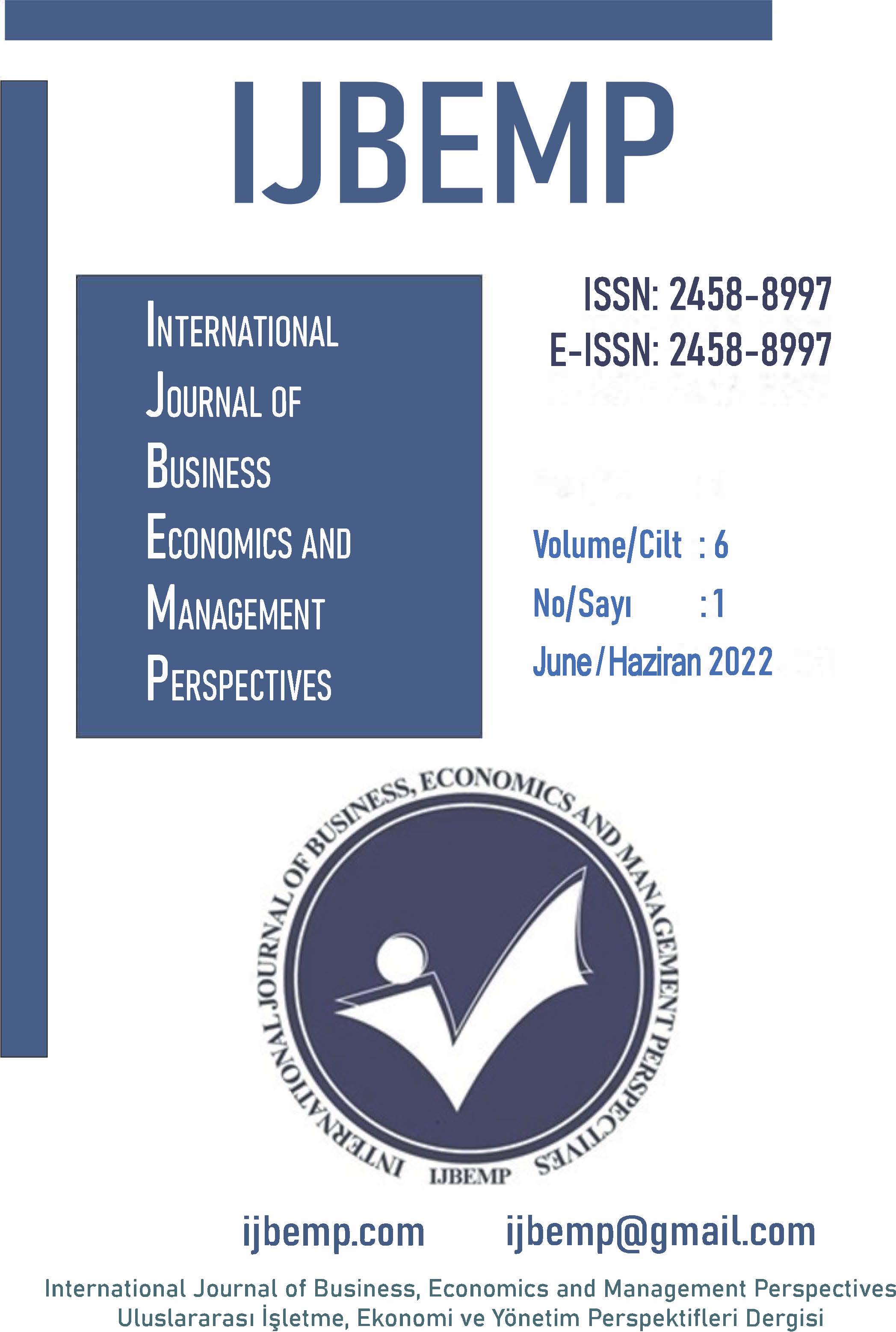Author :
Abstract
Diğer işletmelerde olduğu gibi hastane işletmelerinde de üst yöneticiler tarafından belirlenen hedeflere ulaşabilmek için etkili bir iç kontrol sisteminin tasarlanması ve uygulanması son derece önemlidir. Etkili bir iç kontrol sistemi verimliliğin artırılmasında, risklerin önlenmesinde ve işletme amaçlarına ulaşmada katkıda bulunmaktadır. Bu bağlamda bu çalışmada; birden fazla şubesi bulunan özel bir hastanede iç kontrol sisteminin COSO iç kontrol modeli bileşenleri çerçevesinde bu bileşenlere uyum derecesinin çalışanlarca değerlendirilerek, bu değerlendirmelerin farklı direktörlüklerde çalışanlar açısından farklılaşıp farklılaşmadığının ortaya konulması amaçlanmıştır. Araştırmaya katılanların iç kontrol modeline ilişkin ankette yer alan ifadelere yüksek bir oranda (X̄= 3,81) katıldıkları görülmüştür. Alt boyutlar açısından da; en yüksek düzeyli katılımın “izleme” boyutu içerisinde yer alan ifadelere, en düşük düzeyli katılımın ise risk değerlendirme boyutunda yer alan ifadelere ilişkin olduğu görülmüştür. Ayrıca katılımcıların COSO bileşenlerine yönelik değerlendirmeler açısından, çalıştıkları direktörlükler açısından anlamlı bir farklılık olmadığı tespit edilmiştir.
Keywords
Abstract
As in other businesses, it is extremely important to design and implement an effective internal control system in hospital businesses to achieve the goals set by senior managers. An effective internal control system contributes to increasing efficiency, preventing risks and achieving business goals. In this context, in this study; in a private hospital with more than one branch, it is aimed to evaluate the degree of compliance of the internal control system with these components within the framework of the COSO internal control model components by the employees and to reveal whether these evaluations differ in terms of employess in different directorates. It was observed that the participants of the research highly agreed (X̄= 3,81) with the expressions in the questionnaire regarding the internal control model. In terms of sub-dimensions; it was observed that the highest level of participation was related to the statements in the ‘monitoring’ dimension, while the lowest level of participation was related to the statements in the risk assessment dimension. Moreover, it was determined that there was no significant difference in terms of the evaluations of the participants’ COSO components, in terms of the directorates they worked with.
Keywords
- Aksoy, T. (2005), “Ulusal ve Uluslararası Düzenlemeler Bağlamında İç Kontrol ve İç Kontrol Gerekliliği: Analitik Bir İnceleme”, Mali Çözüm-72 Dergisi, 138-164.
- Aytaç, A. (2014), İç Kontrol Sisteminin Etkinliğinin Değerlendirilmesi ve Bir Uygulama. Yüksek Lisans Tezi, Uludağ Üniversitesi Sosyal Bilimler Enstitüsü İşletme Anabilim Dalı Muhasebe Finansman Bilim Dalı, Bursa.
- Can, E. N. - Çetin, C. (2016), “Devlet Üniversitelerinde İç Kontrol Sisteminin İşleyişine Yönelik Bir Araştırma”, Girişimcilik ve Kalkınma Dergisi 11 (2), 108-140.
- Ceyhan, İ. F. - Apan, M. (2014), “COSO İç Kontrol Modelinin Yapısal Eşitlik Modeli ile İncelenmesi: Bir Hastane Uygulaması”, Mehmet Akif Ersoy Üniversitesi Sosyal Bilimler Enstitüsü Dergisi 6 (10), 179-198.
- Cömert N. (2019), Bütünleşik Yaklaşımla Kobilerde Risk Temelli İç Kontrol (Bölüm 6: İç Kontrollerle İlgili Teorik Çerçeve İç Kontrol Kavramı), Gazi Kitabevi, Ankara, 119-196.
- Dursun G. D. - Akın, S. (2019), “Türkiye’de Özel Hastanelerde İç Kontrol Sisteminin Önemi”, Izmir Democracy University Health Sciences Journal Iduhes 2 (1), 48-60.
- Erdoğan, B. - Mengi, B.T. (2018), “Hata ve Hilelerin Önlenmesine Yönelik Kontroller ve Sağlık Sektörü Üzerine Bir Uygulama”, Giresun Üniversitesi İktisadi ve İdari Bilimler Dergisi 4 (8), 85-106.
- Fidan, M. - Mumcu, E. Ş. (2019), “Madencilik Sektöründe Faaliyet Gösteren İşletmelerde İç Kontrol ve Hile Riski: Bir Mermer İşletmesi Üzerine İnceleme”, Karamanoğlu Mehmet Bey Üniversitesi Sosyal ve Ekonomik Araştırmalar Dergisi, 21 (37), 61-81.
- Gökçen, G. - Tipi, O. (2019), “İşletmelerde Hilelerin Önlenmesine Yönelik İç Kontroller ve BIST İmalat Sektöründe Bir Araştırma”, Marmara Üniversitesi İktisadi ve İdari Bilimler Dergisi 41 (1), 145-169.
- Gönen, S. (2007), Konaklama İşletmelerinde Muhasebe Organizasyonu ve İç Kontrol Sisteminin Etkinliğinin Arttırılmasına Yönelik Bir Uygulama. Doktora Tezi, Dokuz Eylül Üniversitesi Sosyal Bilimler Enstitüsü İşletme Anabilim Dalı, İzmir.
- Hacıhasanoğlu, T, - Kaya, E (2018), “Üretim İşletmelerindeki İç Kontrol Sisteminin COSO Standartlarına Uyum Derecesinin Belirlenmesi: Kocaeli İli Örneği”, MANAS Sosyal Araştırmalar Dergisi 7 (4), 241-266.
- Kara, M. (2018), Kalite Yönetim Sistemleri İle İç Kontrol Sistemi Uygulamaları Arasındaki Etkileşimin Değerlendirilmesi ve Bir Araştırma, Doktora Tezi, İnönü Üniversitesi Sosyal Bilimler Enstitüsü İşletme Anabilim Dalı Muhasebe Finansman Bilim Dalı, Malatya.
- Kertiş, S. (2005), Hastane İşletmelerinde İç Kontrol Sistemi ve Özel Bir X Hastanesinde Uygulanması. Yüksek Lisans Tezi, İstanbul Üniversitesi Sosyal Bilimler Enstitüsü İşletme Anabilim Dalı, İstanbul.
- Kurnaz, E. (2020), “Sağlık Sektöründe İç Kontrol Sisteminin COSO İç Kontrol Modeli Bileşenleri Açısından İncelenmesi: Bir Hastane Uygulaması”, Mali Çözüm Dergisi, 30 (157), 163-185.
- Kurt, G. - Uçma Uysal, T. (2019), Bütünleşik Yaklaşımla Kobilerde Risk Temelli İç Kontrol (Bölüm 7: Kobi’ler İçin Risk Temelli Kontrol Modeli), Gazi Kitabevi, Ankara, 197-213.
- Özgan, H. - Akıncı, E. (2011), Okul Süreç Danışmanlığı Ölçeğinin Geliştirilmesi: Geçerlilik ve Güvenilirlik Çalışması, Uluslararası İnsan Bilimleri Dergisi 8 (1), 1131-1149.
- Sekaran, U. (1992), Research Methods for Business - A Skill-Building App- Instructor's Resource Guide with Test Questions & Transparency Masters, John Wiley&Sons, Incorpo.
- Türk, M. - Çil Koçyiğit, S. (2020), Denetimde Seçme Konular 4: İç Denetim İç Kontrol Sektörel Uygulamalar (Bölüm 3: Hastane İşletmelerinde Risk Değerlendirme Süreci), Gazi Kitabevi, Ankara, 69-88. (Editör: Ü. Aslan ve S. Bozkuş Kahyaoğlu).
- Yamane, T. (2001), Temel Örnekleme Yöntemleri (Çev: Alptekin Esin, M. A. Bakır, C. Aydın, E. Gürbüzsel), Literatür Yayınları, İstanbul.
- Zorlu, M. (2014), Kar Amacı Gütmeyen Organizasyonlarda İç Kontrol ve İç Denetim: Bir Devlet Üniversitesinde Uygulama, Hacı Bektaş Veli Üniversitesi Sosyal Bilimler Enstitüsü İşletme Anabilim Dalı, Nevşehir.





